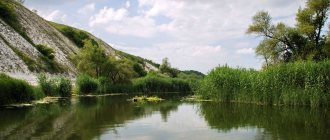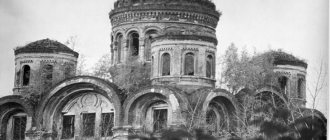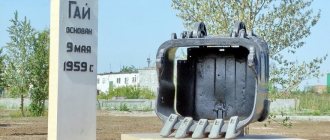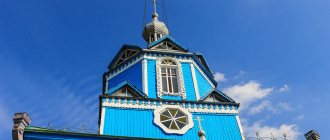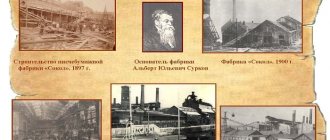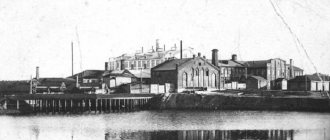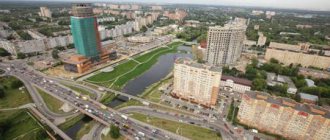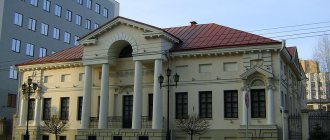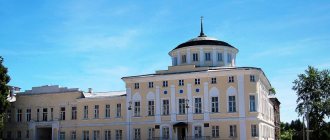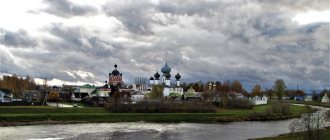| Valuyki |
Valuyki
, a city of regional subordination of the Belgorod region of Russia, the administrative center of the Valuysky district, within the Valuysky deanery, the cathedral center of the Valuysky and Alekseevsky diocese. Located on the high right bank of the Valuy River, 3 km from its confluence with the Oskol River, 152 km east of Belgorod, 15 km from the border with Ukraine. Railway a junction on the Stary Oskol - Starobelsk line, the Novy Oskol - Rovenki highway. Population 34.7 thousand people (2017).
- On the map: Yandex.Map, Google map
Founded in 1593 as a fortified city at the confluence of the Valuy River (modern Valuyka) with Oskol, it was often attacked by the Crimean Tatars.
The name is based on the hydronym, which in a document of 1491 is mentioned as Voluy, in the 17th century in the forms Voluy, Valuy. Presumably, the hydronym is formed from the Old Russian adjective volui “oxen, bull”, and the geographical term river (stream, well) accompanying this definition was lost over time. The common etymology from Kursk and Oryol valui - “a sluggish, clumsy, lazy, open-hearted, rotten person” is less convincing.
In 1699, while traveling to Azov, Peter I visited Valuiki, with whose funds and according to his own plan the cathedral church of the Presentation of the Mother of God of Vladimir was built.
In 1707, the city suffered greatly when it was captured by the troops of K.A. Bulavin.
In 1708 he was assigned to the Azov province, and from 1719 - to the Belgorod province of the Kyiv province.
Since 1727 in the same province of the Belgorod province. Since 1779, the district city of the Voronezh governorship (since 1796 - the Voronezh province).
In 1856, in the district town of Valuiki, Voronezh province, there were five churches, 804 houses, and 30 shops.
At the end of the 19th century, there was a tannery, a distillery, and two oil mills.
Since 1928, Valuiki was part of the Central Black Earth Region, since 1934 - the regional center of the Kursk Region, since 1954 - as part of the formed Belgorod Region.
During the Great Patriotic War, the city was occupied by Nazi troops on July 6, 1942. It was liberated on January 19, 1943 by troops of the Voronezh Front during the Ostrogozh-Rossoshan operation.
The working settlement of Sotsgorodok (PGT since 1940, 3.5 thousand inhabitants, 1959) became part of the city.
The city has art and local history museums, factories: corn calibration, distillery, canning, leather, brick, foundry and mechanical, "Red Metalist". Furniture factory. Energy and construction enterprises. In the Valuysky region, wheat, rye, corn, millet, buckwheat, sunflower, sugar beets, and coriander are grown. They raise cattle, pigs, sheep, and poultry. Deposits of chalk, sand, clay, as well as iron ore and coal.
About the history of the city
The city was founded in 1593 as a small fortress on the Muravsky Way (earthen ramparts, wooden palisade), with a small garrison. In the 17th century, this outpost gradually developed into a full-fledged city, which became the administrative center of Valuysky district. At the same time, the fortress was repeatedly ravaged and burned - by the Polish-Lithuanian gentry and Zaporozhye Cossacks. But it was restored again.
It is known that in 1658 Stepan Razin visited the city. But during the uprising under his leadership (1670-1671), the Valuyek garrison remained loyal to the government.
In the early years of the reign of Peter I, the city of Valuiki was one of the starting points for organizing the Azov campaigns. His fortress was chosen as a gathering point for ground forces in preparation for campaigns and upon return from them. Tsar Peter I also personally stayed in the city.
In 1708, during the uprising of Kondraty Bulavin, the rebels again did not find supporters in the garrison of the Valuiki fortress. Subsequently, it was in it that the son and wife of Kondraty Afanasyevich were held hostage under arrest. In March 1713, the fortress survived the last devastating raid of the Crimean Tatars.
As part of the great administrative reform of Catherine the Great, in 1786 the Voronezh governorship developed a master plan for the development of the city of Valuyki.
In 1840, the construction of the Church of St. Nicholas the Wonderworker was completed in the city, and in 1853, the Vladimir Cathedral was built (it was destroyed in 1932).
The city of Valuiki received little industrial development only in the second half of the 19th century. The fact that the railway ran far from the city did not contribute to its progress.
However, at the end of the 19th century (1895-1897) the railway finally came to Valuiki and somewhat revived the local economy. But in general, the city remained a patriarchal provincial place in the Russian hinterland.
Soviet power was finally established in Valuyki in November 1918. Since 1928, the city has been the administrative center of the Valuysky district.
From July 6, 1942 to January 19, 1943, Valuiki was under Nazi occupation. The city was liberated by troops of the Voronezh Front during the Ostrogozh-Rossoshan offensive operation. By 1956, the city's housing stock had been completely restored to pre-war levels.
In 1954, the Belgorod region was formed, and the city of Valuyki and the Valuysky district became part of it.
In 1966, it included the urban-type settlement of Sotsgorodok, which arose in 1932 as a settlement for railway workers who worked at the marshalling yard, in the locomotive and carriage depot.
Valuiki is a city primarily of food industry workers and railway workers. The products of local food enterprises: sugar, dairy, distillery, vegetable oil plant are well known far beyond the borders of the Belgorod region. As in most provincial towns in Russia, the population of Valuyka is gradually decreasing every year.
After the outbreak of the military conflict in eastern Ukraine, a motorized rifle regiment transferred from Samara was stationed in the vicinity of Valuyki, for which a military camp was built near the city.
Economy and industry of the city of Valuyki
The city has an excellent raw material and production base for the food processing industry. Therefore, many enterprises are engaged in processing agricultural products. The map of Valuyki with houses will help you find all the important industrial facilities in the city. Such enterprises include:
- vegetable oil plant;
- sugar beet processing plant;
- distillery production;
- canning production;
- meat processing plant;
- dairy plant;
- corn calibration plant.
The city also has a brick factory, a furniture factory and a tannery. The sugar processing plant is considered the largest sugar beet processing plant in Russia.
In the vicinity of the city, sugar beets, corn, wheat, and sunflowers are grown. They also raise cattle, poultry, pigs and sheep. Iron ore, chalk, sand and coal are mined in this area.
The city administration plans to build residential buildings in the southeast of the city, in the area of the sugar factory and in the northwest, where the poultry farm is located.
Landscaping and landscaping of the entire area is currently underway. Measures are also being taken to improve transport networks to connect new areas with the old city.
Valuysk Historical and Art Museum
One of the oldest cultural institutions in the city of Valuiki was founded in 1964. For twenty years, the museum’s exhibition was located in different rooms (mainly in the assembly hall of Valuysk City Secondary School No. 1). For some time the museum was located in the former house of the Oleinikov merchants; in vocational school No. 28. And in 1983, it found its own building. And not just a simple one, but one that is considered one of the main architectural symbols of the city. The museum's collection is housed in a historical building built in 1913 - the former Zemstvo Higher Primary School.
This building, designed by the architect Alexey Stepanovich Kunichev, combines the styles of Art Nouveau and Classicism. The facade of the building has a slight protrusion in its central part - the risalit.
Valuysk Historical and Art Museum
After the revolution, the elementary school was renamed the Lenin Model School, and after the Great Patriotic War, this building housed a junior high school. In the 1960-1970s - the basic school of the Valuysky Pedagogical School.
In the interiors of the museum building, the main staircase with forged openwork fencing and decorative decorations have been preserved. During the restoration in 2001-2003. Lost decorative decorations were also recreated - molded cornices, rosettes, friezes.
The History and Art Museum includes two main halls with permanent thematic exhibitions of the section: “History of the Valuysk region from ancient times to the mid-twentieth century” and “Soviet fine art”. The collection includes many household items from various historical eras, church utensils, coins and medals of the 18th-20th centuries. And the art department introduces guests to the rich collection of artists and sculptors of the USSR. In addition to the museum collection, the Valuysk Historical and Art Museum has a solid library collection.
Address: st. Stepana Razin, 16.
House-museum of Army General Nikolai Fedorovich Vatutin
The museum of the outstanding Soviet military leader Nikolai Fedorovich Vatutin was created in his native village, by decision of the collective farm board in 1950. The first director of the museum on a voluntary basis was Nikolai Fedorovich Vatutin’s sister, Daria Fedorovna. And in 1968, the village of Chepukhino itself was renamed Vatutino. The museum is located in the very house where the famous commander was born and raised.
House-museum of Army General Nikolai Fedorovich Vatutin
This house was built in 1849 by the grandfather of the future military leader, Grigory Dmitrievich Vatutin. It is located on the outskirts of the village, near the chalk mountains, next to the Palatovka River.
In a mud hut, under a thatched roof, with a total area of 36 sq. meters lived about thirty people: the family of the grandfather - Grigory Dmitrievich Vatutin; his brother with his family and the family of Nikolai Fedorovich: his mother Vera Efimovna, father Fedor Grigorievich and 9 children.
In 1945, soldiers of the First Ukrainian Front, commanded by N.F. Vatutin, built another house for his mother and her family. It has also been preserved and restored.
Vatutin's mother's house
Nikolai Fedorovich’s relatives collected the commander’s personal belongings, rural household items, and family photographs for the museum. This is where the museum began.
The exhibition, which was created in the house-museum, was housed in 4 rooms. The exhibition was based on historical, chronological and complex thematic principles. This exposition played a significant role in the military-patriotic education of schoolchildren, youth, and other categories of the population of the region.
A significant update and addition to the exhibition was made in 2001, on the 100th anniversary of the birth of the Hero of the Soviet Union, who went through the entire war and died in 1944 in Western Ukraine at the hands of Bendera.
On May 5, 2022, a monument to Vera Efimovna Vatutina, the general’s mother, was solemnly unveiled in the courtyard of the Mother’s House.
Address: Valuysky district, village of Vatutino (formerly Chepukhino), st. Melovaya, 15.
Church of St. Nicholas the Wonderworker
The city of Valuiki has its own Red Square - the best place for evening walks. On it stands the Church of St. Nicholas the Wonderworker, which is rightfully considered the architectural symbol of the city. The construction of this church was completed in 1840, and it stands out for its elegant architectural appearance in the New Russian style and excellent interior design.
Church of St. Nicholas the Wonderworker
In the 1930s, the issue of demolishing the temple was considered. But in the end they limited themselves to removing the crosses from the domes, as well as the bells from the belfry; and the building was used as a warehouse. However, services in the temple were resumed already in 1946.
Address: st. Red Square, 7.
Routes on the map of Valuyki. Transport infrastructure
Its convenient location on the border of Russia and Ukraine allowed Valuyki to become a major railway point through which most transit cargo flows, stopping at the Valuyki-sorting station.
For the needs of citizens, the Valuiki-passenger railway station has at the address Valuiki, Privokzalnaya Square, 1, where there is a customs office. About 50 trains pass per knock in both directions.
Highway 14K-8 of public use of regional significance of the Belgorod region Novy Oskol - Valuyki - Rovenki passes through the city.
Also to the northeast there is a public road 14K-10 of regional significance of the Belgorod region Valuyki - Alekseevka - Krasnoe (Nikitovka - Alekseevka - Krasnoe).
There is a bus station located at Club Street, 2/1, opposite the railway station, from which intercity transportation is carried out.
The city of Valuiki has developed public transport - in total there are about 60 minibuses, 118 buses, most of which are represented by individual entrepreneurs. Thanks to developed competition, the vehicle fleet and the general condition of public transport are in good condition, meeting modern criteria.
There is also an airfield, but it is used exclusively for agricultural needs.
Assumption Nikolaevsky Monastery and cave monastery with temple
Valuysky Assumption Nikolaevsky Monastery was founded at the end of the 16th century. The monastery was one of the poorest in the Voronezh diocese. In 1766, after the reform of Catherine II, the state took away all its lands and almost all property from the monastery, and it became completely unemployed: there were only a few brethren, mostly transferred from other monasteries of guilty monks.
But gradually the monastery is being renovated and equipped, and the heavily dilapidated Assumption Church is being reconstructed. In the 1810-1820s, the first stone structure in the monastery was erected - the two-story Assumption Cathedral. In 1839, the bell tower was illuminated, and construction began on the temple in the name of the “Three-Handed” Icon of the Mother of God. In 1906, the foundation of St. Nicholas Cathedral was laid, the opening of which took place in 1913, on the 300th anniversary of the Romanov dynasty.
The monastery existed until 1924, when, by decision of the Soviet authorities, a colony for minors was located on its territory. The revival of the monastery began in 2001, when the Ministry of Justice of the Russian Federation transferred its surviving buildings to the Russian Orthodox Church.
Entrance to the underground temple
In 1897, for privacy, the hermit monks organized a monastery outside the monastery. A wooden house was built, and then the caves were expanded, deepened and fortified a kilometer from the monastery, across the Oskol River. The temple of the Hieromartyr Ignatius the God-Bearer was created in the underground passages. It was a round hall, about 6 meters in diameter and up to 3 meters high, which could accommodate more than thirty people at a time during services.
The official opening of the cave complex and the illumination of the temple took place in 1914. At the top of the mountain, above the cave monastery, a wooden Church of the Transfiguration of the Lord was erected.
In 2005, the restoration of the Church of Ignatius the God-Bearer and the restoration of the cave monastery began. The lighting of the temple took place in 2007. There are excursions to the monastery. The length of the caves is 640 meters.
Location: Valuyskoye forestry, within the boundaries of the Simonovo-Yablonovo tract, square 70.
The ancient city of Valuiki and the birthplace of General Vatutin
How to get there
By bus
Direct buses depart from the Belgorod bus station every day at 9:20, 12:25, 13:00, 16:50, 17:40, 19:10, 20:00. On Sundays there are additional flights at 8:35, 10:30, 16:00, and on Fridays and Saturdays at 16:00 and 18:30. In addition, you can use transit flights: Belgorod - Veidelevka (7:30, 12:00, 15:00), Belgorod - Rovenki (8:00, 14:00, 15:45, and on Sundays also at 18:30 ), Kursk – Valuyki (9:50, 16:30). The last bus departs back to the regional center from the Valuyskaya bus station on weekdays at 18:00, on weekends at 19:00. Buses run every hour and a half.
By car
When traveling by car, follow the Belgorod – Shebekino – Volokonovka highway. When entering the village of Volokonovka, be guided by the local landmark - the monument “MiG-21PF Aircraft”. Turn right and follow the straight route again without turning anywhere. After passing through the railway crossing, continue moving forward until you reach Gorky Street. This is one of the longest Valuyek streets, which will lead to the city center, where it is best to start getting acquainted with it.
Seven must-see places
City center
It is better to start getting acquainted with the city from its center. There are many buildings with centuries-old history located here. It is not difficult to notice them in the general plan of modern architectural structures. One of the most ancient buildings in the city is St. Nicholas Church . It was built in 1840 with donations from parishioners. It's easy to find. It was located literally a few tens of meters from the local administration building. From the church, we advise you to go up Proletarskaya Street and get acquainted with another ancient building of the city, which now houses the Children's Art School No. 1 . In 1919, it housed the headquarters of the 1st Cavalry Army, and before the revolution - Ilyushchenko’s rooms (hotel).
Central square of Valuyki.
We recommend crossing the road near the House of Justice located next door. You will immediately see a red two-story building. This is the brainchild of the Zemstvo Administration technician Alexei Kunichev, which houses the Valuysk Historical and Art Museum. You don’t have to go far: right opposite the museum there is the Alley of Heroes , on which there are busts of 16 Valuysk Heroes of the Soviet Union and 4 Valuysk Heroes of Socialist Labor. Behind it is the administration building, the central square and the park.
Basic school (secondary school no. 1). Photo by Olga Mushtaeva
2 houses away from the History and Art Museum you will see a white old building called the Basic School . Aircraft designer Konstantin Alekseevich Kalinin studied here in 1902–1907, in 1919 it housed the hospital of the 1st Cavalry Army, and now it is a regular secondary school. We continue our walk. Opposite the Basic School, along 9th January Street, another “Kunichevsky building” will again appear before your eyes - the first public library built in 1910. Just like a little over a century ago, it houses the Intersettlement Central Library of the Valuysky District. Right behind the library is the Palace of Culture.
Historical and Art Museum
st. Stepana Razina, 16 Working hours: on weekdays - from 8:00 to 17:00, break from 13:00 to 14:00 on weekends - from 9:00 to 17:00 without a break, day off - Monday
Tel.: (47236) 3-22-11 and 3-13-89 www.valmuseum.ru
Valuysk Historical and Art Museum. Photo of Valuysky Historical and Art Museum
Like many buildings in the city, the red brick house, which formerly housed the Higher Primary School, was built in the Russian Art Nouveau style in 1913 according to the design plan of the Zemstvo Administration technician Alexei Kunichev. And the museum itself was founded in 1964 by People’s Artist of the Kyrgyz SSR Alexander Illarionovich Ignatiev. The museum's holdings include more than 7 thousand exhibits. They are presented in the exhibitions of two sections: “Soviet fine art” and “History of the Valuy region from ancient times to the mid-twentieth century.” But a visit to the museum will introduce visitors not only to the work of artists and will reveal the secrets of the Valui land. Here you can find out about excursion routes around the city and region. By the way, to date, museum staff have developed seven of them: five on-site and two on foot.
St. Nicholas Cathedral
Microdistrict Expanse
St. Nicholas Cathedral is the largest operating church in the Belgorod region. It was founded in 1906 as the main temple of the Valuysky Assumption Nikolaevsky Monastery and opened in 1913 on the 300th anniversary of the reigning Romanov dynasty. But he did not have the chance to serve the people for long. In the 30s of the last century, the cathedral fell into disrepair and was closed. The crosses were torn off the cathedral and they found another practical use for it - they placed a foundry in it. It is no wonder that the foundry negatively affected the internal condition of the temple, especially the artistic paintings. But it was precisely this use of the temple that saved it from complete destruction.
St. Nicholas Cathedral of the Assumption Nicholas Monastery. Photo of Valuysky Historical and Art Museum
Afterwards, the cathedral remained half destroyed for many years, and only in 2008, on the initiative of the then Archbishop of Belgorod and Stary Oskol John, restoration of the cathedral began. And already on September 4, 2011, the historical and cultural monument again began to live a new life.
Cave Monastery of Ignatius the God-Bearer
Microdistrict Expanse
A unique monument of Orthodoxy with a length of caves of about 600 meters, the width of which is about 89 cm, and the height is about three meters, is located a kilometer from the main territory of the Valuysky Assumption Nikolaevsky Monastery behind the Oskol River on the ledge of a chalk mountain. The exact time of the founding of the St. Ignatievsky cave monastery has not been established, but documentary sources state that in 1897, “due to the unsatisfactory condition of a number of underground galleries, a complex of restoration work was carried out.” Then the dangerous places in the walls and ceilings of the caves were strengthened, and the resulting cracks and crevices were sealed with plaster. And already on May 4, 1914 it was opened. After the war, the cave complex was in a ruined state for a long time. The restored complex opened in 2007.
House-Museum of Army General N. F. Vatutin
With. Mandrovo Tel.: (47236) 9-23-39 Opening hours: from 8:00 to 16:00, without breaks; Weekends – Sunday, Monday www.museum.ru/M728
The family estate of the Vatutin family in the village of Mandrovo, Valuysky district. Photo of Valuysky Historical and Art Museum
The creation of the museum began in 1950. This year, a museum in his memory was opened in the house where the future general was born. And years later, in 1985, they created an entire memorial complex “House-Museum of Army General N.F. Vatutin,” which included the family estate of the Vatutin family and a house built in 1945 by soldiers of the 1st Ukrainian Front (N.F. Vatutin was the front commander until 1944) for the mother and sisters of Nikolai Fedorovich. “Revived history” refers to the museum’s exhibition telling about the general’s peaceful and military life. Here are personal belongings of the Vatutin family, uniforms of the famous countryman of the 30s and 40s, awards, documents, photographs and even books from his personal library.
Temple complex "New Jerusalem"
With. Sukharevo
A unique corner of the Valuysk land is the temple complex “New Jerusalem” - a kind of analogue of the holy city. Everything here reminds of the Holy Land: both architectural buildings and topographic names. So, you will enter the temple complex through the holy Entrance Gate, here there is an Orthodox oak cross of the crucifixion of Jesus Christ, the Stone of Anointing, the Edicule of the Holy Sepulcher, as well as the chapel of the “Sovereign” icon of the Mother of God, the Church of St. John the Baptist with a bell tower. What is interesting is that the construction of the temple has not been completed to this day; it is being carried out as funds become available.
Temple complex New Jerusalem in the village of Sukharevo, Valuysky district. Photo of Valuysky Historical and Art Museum
It was no coincidence that they decided to build a temple near the village of Sukharevo. It turns out that from word of mouth local residents pass on the legend that in ancient times there really was a New Jerusalem here. They intersperse evidence into their stories. They assure that the memory of this is preserved in topographic names. So, near the village there is the hill of the prophet Micah, or Mount Golgotha, the Mount of Olives, and the spring of Jacob. And according to the version of the priest of the Vvedensky Church, Alexander Manshin (named Theodore), on these lands in ancient times, the disciples and followers of the Apostle Andrew the First-Called founded a village. The chosen place reminded them of the Holy Land, where they themselves came from. The new village was given the name “Shechem”, or “Sikhar”, which over time changed to “Sukharevo”.
Apiary A. M. Sukhareva
village Urazovo, st. Lugovaya, 58 Tel.: (47236) 2-12-94, 8-960-638-34-98
Nature lovers will not leave indifferent the apiary of Alexander Sukharev. It is located in the forest belt of the village of Urazovo. A visit to this picturesque corner promises to be very educational as well. Having put on a protective net, you will see the entire process of honey production: from collecting nectar to building honeycombs. At the end of the excursion, you can taste honey, drink herbal tea from a real samovar, and also purchase a jar of freshly pumped honey or beekeeping products, the properties of which the owner will certainly tell you about.
Apiary A. M. Sukharev. Photo of Valuysky Historical and Art Museum
You can also just wander around the surrounding area and pick medicinal herbs and strawberries. What’s tempting is that you can come to the apiary to relax for a few days, spend the night in the owner’s hut, or bring a tent with you. The main thing is not to miscalculate with time. Guests are welcome at the apiary from mid-May to October.
Church of the Holy Martyr Ignatius the God-Bearer
The wooden church, built over the cave monastery, was burned down during the revolution. In the early 2000s, it was decided to rebuild it. The above-ground wooden church of the Hieromartyr Ignatius the God-Bearer was built in 2005-2007 on the top of Bald Mountain above the caves and underground church, which were cleared in the same years.
Church of the Holy Martyr Ignatius the God-Bearer
Around the upper church, an observation deck and the areas adjacent to the church were carefully arranged, and a park area was laid out. The upper temple of Ignatius the God-Bearer was consecrated on September 22, 2007. This is a wooden tiered one-story temple, made in the classical Russian style, with a tent-roofed bell tower.
Location: Valuyskoye forestry, within the boundaries of the Simonovo-Yablonovo tract, square 70.
Valuiki on the map of Russia: geography, nature and climate
If we look at the map of Valuyki from a satellite, we will see that geographically the city is located in the very south of the Belgorod region, near the border with Ukraine (about 15 km), on the banks of the Valuy River, which flows into the Oskol River. The regional center of Belgorod is 152 km away.
This area is characterized by a temperate climate: winters are characterized by stable temperatures of about 5 °C, heavy snowfalls in January and February; at the beginning of winter, rain and light frosts are common in the city; In summer, quite high temperatures are observed, the average value for recent years is + 21 °C. Annual precipitation is 580-600 mm. The predominant wind direction for this area is east.
During the entire observed period, several cases of abnormal heat and cold were recorded: + 37.8 °C and -32.2 °C.
Valuyki belongs to the central region of the Russian Federation, and lives in the same time zone as Moscow.
The terrain is mostly flat, with frequent ravines and crevices. The soil is rich in chalk and sandy sediments, which are located quite shallow, due to which sinkholes and quarries are often formed.
The two main rivers of the region - Valuy and Oskol, have a drainage area of 1,340 km² and 14,800 km², respectively, they are characterized by predominantly snow feeding, slow flow, and slight slopes of the riverbed.
In recent years, the local soil has been characterized by erosion, due to which the fertility of the black soil is decreasing.
Saving city New Jerusalem
The unique landmark New Jerusalem, near the village of Sukharevo, is a reproduction of the biblical Jerusalem.
This Orthodox complex includes: the Church of John the Baptist with a bell tower, the chapel of the Mother of God, the chapel of St. Mary Magdalene, the Edicule of the Holy Sepulcher, the Stone of Anointing, the local Golgotha, the font of the Apostle John the Theologian.
Saving city New Jerusalem
The temple complex of New Jerusalem is surrounded by a palisade of planed and sharpened logs, and the entrance is decorated with the “Holy Entrance Gate”. Nearby there is a locker with head capes and skirts, you can wear them for free. Around the city from the hill there is a wonderful view, full of tranquility - this is a special place, one of those called “places of power”.
Location: near the village of Sukharevo.
House of the Oleinikov merchants
This substantial two-story merchant mansion was built in 1911. On its pediments there are stone inscriptions: “1911 Y. Kh. and P. I. Oleinikovs.” After the revolution, the building was nationalized. Over the years, it housed a antenatal clinic, city and children's libraries, an art museum, and a children's clinic.
House of the Oleinikov merchants
By the end of the 20th century, the house, which had not yet received repairs, was declared unsafe, and it stood abandoned until 2011. Then the building was reconstructed - with the replacement of all interior decoration, windows, doors, communications. The facade of the mansion was left in its historical form. The renovated building houses the district education department.
Address: st. Timiryazev (Cemetery), 123.
Tax newsletter Valuek.
On December 1, the deadline for paying property taxes for individuals calculated for citizens for 2022 expired. The obligation of citizens to pay taxes on time is enshrined in the Constitution of the Russian Federation, and this is also stated in the Tax Code. Unfortunately, as practice shows, for one reason or another, not all citizens and not always manage to fulfill this requirement. In this case, the amount of tax not paid on time is an arrears, or tax debt. This entails a number of negative consequences for the taxpayer, such as the accrual of penalties on the unpaid amount, the imposition of a fine by the tax authority, the collection of arrears, penalties and fines. In addition, a number of enforcement measures may be applied to debtors, including seizure of property by the bailiff service and a ban on traveling outside the Russian Federation. In this regard, we recommend that citizens do not wait for extreme debt collection measures, but voluntarily repay the existing arrears as soon as possible. You can obtain information about the presence or absence of tax debts using the “Taxpayer Personal Account for Individuals” service on the website of the Federal Tax Service of Russia. Let us remind you that you can log into the service using an account from the government services portal; please note that for this the account must be verified. Payers of the Unified Agricultural Tax will be able not to use online cash registers in markets For payers of the Unified Agricultural Tax, when selling food products at retail markets, fairs and exhibition complexes from retail spaces with an area of no more than 15 square meters. m. (including places for storing goods), amendments made to the Federal Law of May 22, 2003 No. 54-FZ “On the use of cash register equipment when making payments in the Russian Federation” preserved the benefit of not using cash register equipment. At the same time, it is important to keep in mind that this benefit does not apply to organizations and individual entrepreneurs making payments for goods that are subject to marking with identification means in accordance with the legislation of the Russian Federation. If you fall under the criteria for the benefit, have the right to use the unified agricultural tax and plan to take advantage of the benefit provided for by the amendments, then you must exercise your right to switch to the unified agricultural tax no later than December 31, 2021. The amount of tax on PSN can be reduced by the amount of paid insurance premiums. Individual entrepreneurs using the patent tax system (hereinafter referred to as PSN) can reduce the amount of tax on PSN by the amount of paid insurance premiums (clause 1.2 of Article 346.51 of the Tax Code of the Russian Federation). At the same time, taxpayers making payments and other remuneration to individuals have the right to reduce the amount of tax by the amount of insurance payments (contributions) and benefits, but not more than by 50 percent. Taxpayers who do not make payments and other remuneration to individuals have the right to reduce the amount of tax on insurance premiums paid for compulsory pension insurance and compulsory health insurance without applying a limitation. If an individual entrepreneur received several patents in a calendar year, he can reduce the tax on paid insurance payments (contributions) and benefits for each of them. In this case, the condition for limiting the reduction in the amount of tax for each patent must be met, and the total amount of reductions must not exceed the amount of insurance payments (contributions) and benefits paid this year. It is impossible to reduce the tax paid in connection with the use of PSN by insurance payments (contributions) and benefits that were taken into account when calculating taxes paid in connection with the use of another taxation system. To reduce the amount of tax by the amount of insurance premiums, it is necessary to submit a corresponding notification to the tax authorities at the place of registration (form according to KND 1112021). It has become easier to offset overpayments of taxes. It is known that now offsets of overpayments can be made between budgets of different levels, but taxes can only be offset against taxes, and contributions - against contributions transferred to the budget of the same fund where the overpayment occurred. From January 1, 2022, overpayments of taxes can be offset against the payment of fees and contributions. Corresponding changes to tax legislation were introduced by Federal Law dated November 29, 2021 N 379-FZ. Let us remind you that tax authorities can carry out offsets independently or at the request of the taxpayer (clause 1.1 of Article 78 and clause 1.1 of Article 79 of the Tax Code of the Russian Federation). From 2022, the amount of fixed contributions paid by individual entrepreneurs will change. Individual entrepreneurs calculate the amount of insurance premiums payable for the billing period independently. The amounts of insurance premiums are calculated by payers separately in relation to insurance premiums for compulsory pension insurance and insurance premiums for compulsory health insurance. In 2022, the amount of fixed contributions paid by individual entrepreneurs will increase and amount to 34,445 rubles for insurance premiums for compulsory pension insurance, 8,766 rubles for insurance premiums for compulsory health insurance. Let us remind you that taxpayers pay the amounts of insurance premiums for the billing period no later than December 31 of the current calendar year, while individual entrepreneurs independently determine the frequency of payments (monthly, quarterly, once a year). Citizens will be able to receive a tax deduction for fitness Starting with income in 2022, citizens will be able to receive a new social deduction for physical education and health services. A prerequisite is the inclusion of the organization providing such services in a special list (approved by Order of the Ministry of Sports of the Russian Federation dated November 23, 2021 No. 910). The deduction will be available for both yourself and your minor children. The amount of tax deduction is limited to 120,000 rubles per calendar year, that is, the maximum amount to be refunded will not exceed 15,600 rubles. The unused deduction amount is not carried over to the next calendar year. To apply for a deduction, you will need to confirm receipt of services with documents confirming expenses (copies of contracts and cash receipts for payment for services). From January 2023, taxpayers will be able to independently claim the deduction by submitting a 3-NDFL declaration. In addition, this deduction can be received at work. The employer will provide it upon notification from the tax authority based on the employee’s application (Article 219 of the Tax Code of the Russian Federation, Article 2 of Law No. 88-FZ). Unaccounted for objects of taxation must be reported to the tax office before December 31. December 1, the deadline for individuals to pay property taxes for 2022 has expired - Accruals on property objects subject to taxation were contained in notifications sent by mail or through the “Taxpayer’s Personal Account for Individuals” on website of the Federal Tax Service of Russia. If a tax notification has not been received or there is no property item (car, land plot, apartment, etc.) in it, the citizen sends a message to the tax authority about real estate objects, land plots and vehicles. The exception is cases when an individual has received a tax notice for the specified objects at least once or has been granted a benefit in the form of tax exemption. The deadline for sending such a message in relation to objects already owned in 2022 is until December 31, 2022. For failure to fulfill the obligation to send a report to the tax authority about unregistered objects, a fine is provided in the amount of 20% of the unpaid amount of tax in relation to the property or transport for which the report was not submitted. Detailed information on the preparation, timing and procedure for submitting a report on objects not reflected in the tax notice, and liability for failure to submit it, is contained on the website of the Federal Tax Service of Russia in the section “Individuals” (“Submission of a report on the availability of property”). From the new year, new rules for obtaining an electronic signature come into force. From January 1, 2022, the Federal Tax Service of Russia will be entrusted with the functions of issuing a qualified electronic signature (CES) for legal entities, individual entrepreneurs and notaries. On the territory of the Belgorod region, CEPs are issued by: Interdistrict Inspectorate of the Federal Tax Service of Russia No. 4, 5, 6 for the Belgorod region, Inspectorate of the Federal Tax Service of Russia for the city. Belgorod, Belgorod branches No. 1 and No. 2 of the Foundation Center. To obtain a CEP, you must have with you: an identity document, SNILS, a USB key information carrier (token) for recording a qualified certificate and an electronic signature key, certified by the FSTEC of Russia or the FSB of Russia. You can purchase such media from manufacturer distributors and in specialized online stores. You can also use existing media as long as it meets the requirements. The most convenient way to prepare and submit an application for the issuance of a qualified certificate. More information about the new procedure for obtaining a CEP can be found on the website of the Federal Tax Service of Russia in the section “Procedure for obtaining an electronic signature.” Documents related to the application of the simplified tax system can be submitted to any tax authority. The Tax Service has implemented the principle of extraterritoriality when submitting documents related to the application of the simplified taxation system to the tax authority. The corresponding clarifications are given in the letter of the Federal Tax Service of Russia dated November 24, 2021 No. SD-4-3/ [email protected] Let us recall that in accordance with paragraph 1 of Article 346.13 of the Tax Code of the Russian Federation, organizations and individual entrepreneurs who have expressed a desire to switch to the simplified tax system from the next calendar year , must submit to the tax authorities a notification of the transition to the special regime by December 31 of the current year.
Newly created enterprises and registered individual entrepreneurs can decide on the choice of a simplified system no later than 30 days from the date of registration (Clause 2.Article 346.13 of the Tax Code of the Russian Federation). In the event of termination of an activity in respect of which the simplified tax system was applied, the taxpayer is obliged to notify the tax authority about this within 15 days (Clause 8.Article 346.13 of the Tax Code of the Russian Federation). The updated software allows the taxpayer to submit the following forms of documents to any tax office: - notification of transition to the simplified tax system (form No. 26.2-1) (KND1150001); — notification of loss of the right to use the simplified tax system (form No. 26.2-2) (1150003); — notification of refusal to use the simplified tax system (form 26.2-3) (KND-1150002); — notification of changes in the object of taxation (form 26.2-6) (KND 1150016); — notification of termination of business activities in respect of which the simplified tax system was applied (form 26.2-8) (KND 1150024). The rules for filling out payment documents have changed. From October 1, 2022, in payment orders for the transfer of taxes, fees, contributions and other payments administered by tax authorities to the budget, a number of fields must be filled out in a new way. The corresponding changes were made by order of the Ministry of Finance dated September 14, 2020 No. 199n. The main change concerns individual entrepreneurs, notaries, lawyers and heads of peasant farms. Thus, from the specified date the corresponding codes are abolished: “09”, “10”, “11”, “12”. Instead, in field 101 “Payer Status” the value that is common for all of the above categories of payers will be used – “13”. From the above date, codes “09”, “10”, “11” and “12” will no longer be valid. At the same time, the rules for indicating the status for tax agents with code “02” when issuing a payment document for the payment of personal income tax for employees or VAT (for example, when renting state or municipal property) remained the same. At the same time, the procedure for indicating information when repaying debts for expired tax and settlement (reporting) periods is changing. In field 106 “Basis of payment” it is necessary to indicate only the code of the basis of payment “ZD”, which is currently used for voluntary repayment of debt. The codes previously used in field 106 “Number of the basis document”: “TR”, “PR”, “AP” and “AR” will need to be indicated in field 108 before the number of the basis document (for example, TR0000000000000 - the number of the Federal Tax Service's request for tax payment, collection, insurance premiums or PR0000000000000 – number of the decision to suspend collection, etc.). In this case, in field 109 “Date of document-basis of payment” it is necessary to indicate the date of preparation of the corresponding document on the basis of which funds are transferred. To avoid classifying a payment as an outstanding receipt, you must follow the new rules for filling out payment orders. You can quickly and accurately fill out a payment order on the website of the Federal Tax Service of Russia, using the “Payment of taxes and duties” service. CCP must not only be registered, but also applied! Interdistrict Inspectorate of the Federal Tax Service of Russia No. 3 for the Belgorod Region (hereinafter referred to as the inspection), reports the need to purchase and register cash register equipment, as well as record the calculations made in accordance with the requirements of the legislation on the use of cash register equipment. Let us recall that in accordance with paragraph 1 of Art. 1.2 of the Federal Law on the territory of the Russian Federation, organizations and individual entrepreneurs are required to use cash register equipment included in the register. When making payments, the user is required to issue a cash receipt or a strict reporting form on paper. If before the time of settlement the buyer (client) provided a telephone number or email address, then the cash receipt or strict reporting form must be sent to him in electronic form, unless otherwise provided by Federal Law. Inspectorate employees constantly monitor the use of cash register equipment in markets, fairs and other areas designated for trade, subjecting taxpayers to administrative liability in the form of a warning or fine for individual entrepreneurs and officials - at least 10,000 rubles, for legal entities - not less than 30,000 rubles - for failure to use a cash register, as well as in the form of a warning or a fine in the amount of 1,500 to 3,000 rubles - for officials, from 5,000 to 10,000 rubles - for legal entities - for using cash register equipment , which does not meet the requirements, or in violation of the procedure and conditions for its application. There are more preferential categories. Persons with the status of a combat veteran, one of the parents (adoptive parents, guardians, trustees) of a disabled child, participants in the liquidation of the consequences of the disaster at the Chernobyl nuclear power plant, with the adoption of the Law of the Belgorod Region of 04/05/2021 No. 54 received the right to benefits for transport tax. Let us remind you that exemption from payment of transport tax is provided for one vehicle with an engine power of up to 100 horsepower. For cars with a vehicle engine power ranging from 100 to 150 horsepower, a reduced rate is established - 10 rubles per horsepower. Other vehicles are taxed in accordance with the general procedure. You can register as an individual entrepreneur through a mobile application. The mobile application “Personal Account of an Individual Entrepreneur” provides citizens with a unique opportunity to register as an individual entrepreneur the very next business day after submitting an application. The result of the application review will be sent to the applicant’s email on the same day. The application implements a convenient mechanism for generating an application with a quick search for the required types of activities, as well as the ability to submit an application for a transition to a special tax regime. To complete the registration procedure, you must appear at the registration authority once. The application is available for iOS and Android platforms. You can familiarize yourself with the advantages and procedure for installing the service on a special page on the website of the Federal Tax Service of Russia https://service.nalog.ru/gosreg/promo-app21001.html. New rules apply to suspend transactions on taxpayer accounts. Article 76 of the Tax Code of the Russian Federation provides for three cases when an account can be blocked. This is the suspension of transactions on an account for non-payment of taxes (within the amount specified in the decision to suspend transactions on the accounts). Late submission of a tax return or calculation in Form 6-NDFL also entails account blocking. And in this case, there are no restrictions on the blocking amount; the tax authority has the right to block all the money in the accounts. And the third case is blocking for non-compliance with the rules of electronic document management. There is another situation when blocking an account becomes possible if the tax authority has reason to believe that the taxpayer can hide his property from forced collection to pay off debts to the budget. This is a blocking based on the results of an on-site inspection (as an interim measure to counteract the concealment of property). Let us remind you that if an account is blocked, you cannot carry out debit transactions on it. Moreover, if the tax authority issued a decision to suspend operations on accounts, the bank does not have the right to open this company not only new accounts, but also deposits or deposits. And not only the bank where the client is served, but also any other. Previously, the deadline after which the tax authority blocked the taxpayer’s account was 10 working days, from July 1, 2022 it is 20 working days. Therefore, from July 1, 2021, a decision on the suspension of operations on accounts, the tax authority will be able to make a decision from 21 business days (Federal Law of 09.11.2020 No. 368-ФЗ). In addition, the specified law granted the tax authority the right to notify the taxpayer of the upcoming blocking. You can now check the crediting of the payment in your personal account in the personal account of the taxpayer of an individual on the website of the Federal Tax Service of Russia has a new function - “Search for payment”. To verify the enrollment of the user, in the subsection “other situations” of the “Life Situations” section, you need to send a request for a search for funds by receiving the relevant details of the payment. After sending the request, information about the status of payment in the information system of the tax authorities will go to the “personal account of the taxpayer” on average within a day. Similar functionality will be available to individual entrepreneurs and legal entities in the near future. The payment of tax by self -employed the amount of tax payable by self -employed (payers of tax on professional income) is calculated automatically, according to the checks made in the “My Tax” application. The tax is paid monthly no later than the 25th day of the month following the expired tax period (month). If this date is a holiday or weekend, then the payment term is transferred to the first working day. In the period from the 9th to the 12th day of the month following the expired tax period, the tax authority automatically forms a receipt for tax payment and is sent to the mobile application “My Tax” and to the Web Cabinet “My Tax”. If the amount of tax calculated does not exceed 100 rubles, then this tax will be included in the next tax period, until the amount of tax is more than 100 rubles. For the simplicity of payment, the receipt contains a specialized QR code. It should be noted that for the self -employed there are no exceptions in terms of compliance with the requirements of tax legislation and in case of violation of the deadline for the payment of the calculated tax on them, the same measures are applied as to all taxpayers. So, in the event that the tax obligation is not fulfilled on time, the tax authority will send the taxpayer through the mobile application “My tax” the tax payment requirement indicating the information about the amount of tax arrears, the amount of penalties accrued on the day of direction of the claim, about Measures to recover tax and ensure the performance of the tax obligation to pay tax that are applied in case of failure to fulfill the claim. Interdistrict IFTS of Russia No. 3 in the Belgorod Region
December 29, 2021
House of the Zemstvo Doctor Voyutsky
The one-story blue and white building was built at the beginning of the twentieth century. Its windows are decorated with interesting stucco with floral motifs, pilasters and a relief cornice. Fragments of the original decoration have been preserved inside the building. Before the revolution, the family of the zemstvo doctor Voyutsky lived in this house, and it also housed an office for receiving patients. In 1937, the nationalized building was given over to a school of medical and nursery nurses. And in our era, the medical department of Valuysk College is located in it.
House of the Zemstvo Doctor Voyutsky
Address: st. 50 years of the Komsomol, 41.
Urazovsky Museum of Local Lore
In the 18th century, Urazovskaya Sloboda was founded by the princes Golitsyn. The peasants here received freedom half a century before the official reform. The settlement received craft and trade development, and at the beginning of the 20th century its population was larger than in Valuyki.
The theme of the museum is dedicated to the development and culture of Valuysk and Urazovskaya Sloboda. In total, it includes 4 sections. The program is very interesting and rich, and visitors are always received with cordiality. Many believe that this is where the “historical spirit” of the region lives.
Location: Urazovo village, 9th January street - 3.
Valuyskaya Central District Library
The building was built in 1909 on the initiative of the Valuysk district zemstvo government, and from the very beginning it housed a library - the first in the history of the city. Its opening was timed to coincide with the 200th anniversary of the victory of the Russian army in the Battle of Poltava and was called “Petrovskaya”. At one time, the library was headed by Olga Tyutcheva, the great-granddaughter of the famous Russian poet. And in the early 1930s, the famous Communist Party leader Leon Trotsky gave a speech from the balcony of this public library. Epochs succeeded one another, but this building never changed its appearance and purpose. It has been the main city library for more than one hundred and ten years.
Valuyskaya Central District Library
Address: st. January 9, 3.
Main streets of Valuyki
- Maxim Gorky is a main street running in the north-west direction. It starts from the City Administration, passes through the entire city and smoothly flows into the regional highway Novy Oskol - Valuyki - Rovenki (14k-8). The length of the street is more than 4 km, intersects with the streets Gvardeyskaya, Gagarina, 50 let VLKSM, Nikitina and others in the direction. The Central Stadium is located on the street.
- Sokolova is a street in the eastern part of the city with a length of 4.63 km. It starts at 4th Novoselovsky Lane, ends at the intersection with Surzhikova Street, and crosses the street. Shchorsa and other smaller lanes and roads.
- 1st May Street is one of the central streets, laid in a northeast direction. It starts from highway 14k-8, connecting such important objects as the city administration, Valuyskaya Central District Hospital, Central Park, St. Nicholas Church, registry office, palace of culture and sports. The approximate length is 1.75 km, it has an intersection with the streets: Timiryazeva, st. January 9, Oktyabrskaya, Proletarskaya, Kirova.
- Proletarskaya is a district street, directed to the north-west, starting from the military registration and enlistment office and Demyan Bednogo Bednogo street and ends at the street. Chapaeva. On the street there is school No. 2, an art school, a technical school, and a kindergarten. The total length is about 1.5 km; intersects with Gagarin, 1 May, Sverdlov, Stepan Razin streets
- Gvardeiskaya is one of the longest streets in the city, about 4 km long, crosses almost the entire city in the north-east direction, starting from the Oskol River and st. Embankment, and ends at the intersection with regional road 14k-8. Intersects in the direction with the streets: Karl Marx, Kryukova, Proletarskaya, Maxim Gorky, 9 January. On the street there is a distillery and a City Cultural Park.
Memorial complex in honor of those killed in the war and the Alley of Heroes
A memorial complex has been erected on Red Square in the city of Valuyki - the “Grieving Mother” monument and the Eternal Flame. A bronze figure of a woman stands on a granite pedestal. Around it are placed fourteen slabs with the names of 215 Soviet soldiers buried in a mass grave. In front of the statue is the symbolic Eternal Flame. Behind the Mother sculpture is the local Alley of Heroes.
Memorial complex in honor of those killed in the war and the Alley of Heroes
It was opened in 1995, on the anniversary of the 50th anniversary of Victory in the Great Patriotic War. These are sixteen busts of fellow countrymen, marked with the high title of Hero of the Soviet Union, three busts of Heroes of Socialist Labor and a bust of a full holder of the Order of Labor Glory (Lubov Vasilievna Tregubova).
Four of these 16 Heroes of the USSR - natives of the Valuysky region - died in the Great Patriotic War, two more - in the Soviet-Finnish War of 1939-1940, and were awarded this title posthumously. Among them is General Nikolai Vatutin.
Location: city center, Red Square.
Church in honor of the Icon of the Mother of God “The Sign”
Construction was carried out at the expense of Prince Alexander Golitsyn. From the very moment of its discovery, one of the copies from the icon of the Mother of God “The Sign” has been located here. Here, as in many other churches, reconstruction was carried out. The restoration was carried out at the expense of the people. Now the temple amazes parishioners and pilgrims with its extraordinary beauty.
Location: Urazovo village, Red Square.
Monument to Ivan Kozhedub
The monument - the La-5 aircraft - was erected in 19+88 in the village of Urazovo, in honor of the 14th Guards Air Division, which was located in these places during the Great Patriotic War. The monument is located at the intersection of Plekhanov and Lenin streets, next to the local temple. Three times Hero of the Soviet Union Ivan Nikitovich Kozhedub made his first combat flight from the Urazov airfield in March 1943. In 1988, he personally took part in the opening of the aircraft monument. It was on the La-5 that this famous ace pilot fought (at the end of the war - on the newer La-7).
Monument to Ivan Kozhedub
Location: Urazovo village.
